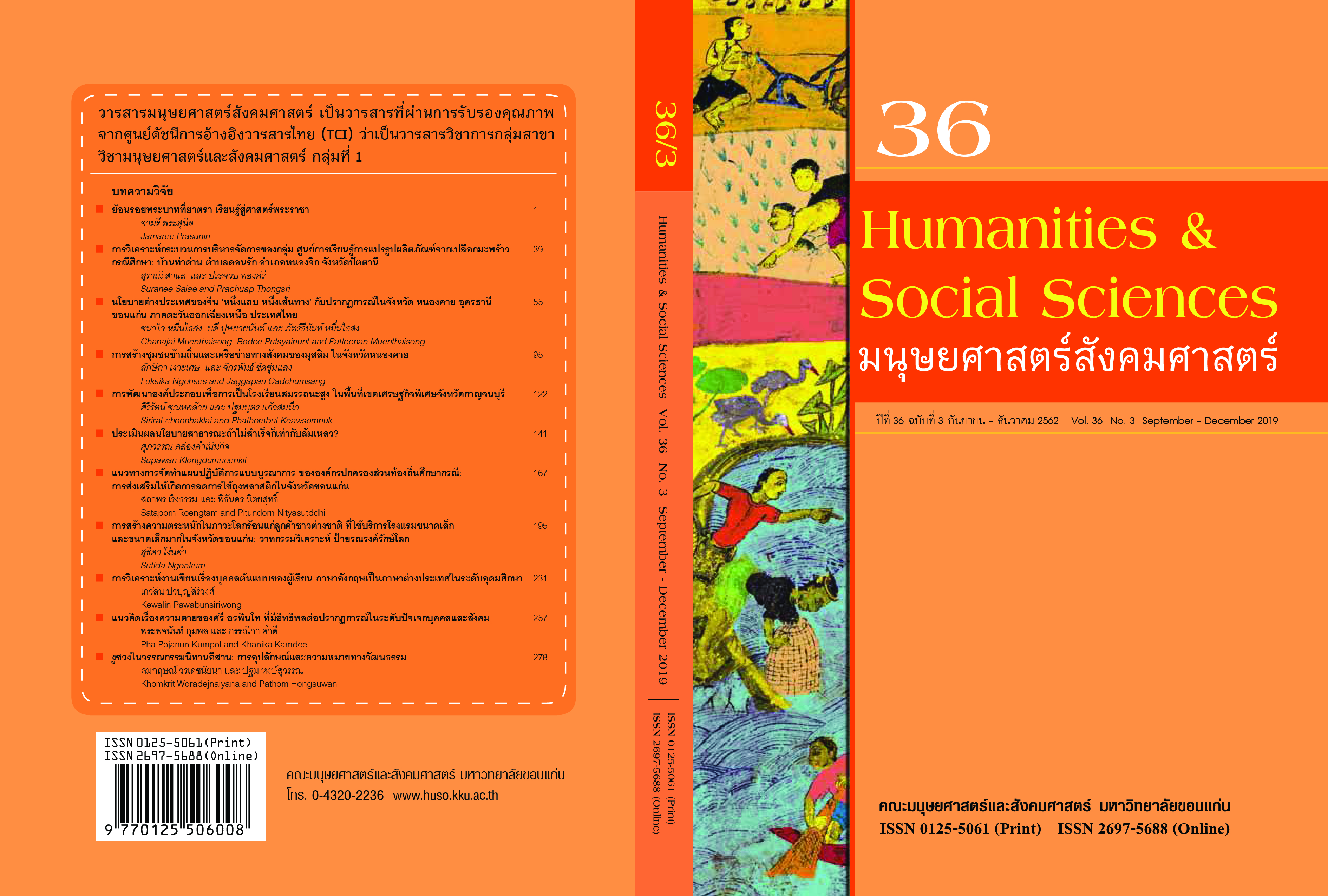การวิเคราะห์งานเขียนเรื่องบุคคลต้นแบบของผู้เรียนภาษาอังกฤษเป็นภาษาต่างประเทศในระดับอุดมศึกษา
คำสำคัญ:
คำสำคัญ: การเขียนบันทึก บุคคลต้นแบบ การเรียนภาษาอังกฤษเป็นภาษาต่างประเทศ นักศึกษาบทคัดย่อ
การมีบุคคลต้นแบบมีประโยชน์ในหลาย ๆ ด้าน เช่น ช่วยให้เราสังเกตและเลียนแบบพฤติกรรมที่ต้องการทำตาม ช่วยให้แนวปฏิบัติที่จะช่วยเอื้อให้เราบรรลุเป้าหมายหรือประสบความสำเร็จได้เร็วขึ้น และในบางครั้งก็ช่วยให้เราหลีกเลี่ยงในสิ่งที่ไม่ควรทำซึ่งอาจนำไปสู่ความล้มเหลวหรือผลลัพธ์ที่ไม่น่าพึงประสงค์ แน่นอนว่าบุคคลต้นแบบมีอิทธิพลทางทัศนคติ ค่านิยม และพฤติกรรมของวัยรุ่นไม่ทางใดก็ทางหนึ่ง นอกจากนี้ลักษณะนิสัยของบุคคลต้นแบบยังช่วยส่งเสริมให้วัยรุ่นต้องการทำความดีและมีน้ำใจต่อผู้อื่น ดังนั้นการมีบุคคลต้นแบบจึงเป็นสิ่งสำคัญสำหรับนักศึกษา อย่างไรก็ตามงานวิจัยเรื่องบุคคลต้นแบบของวัยรุ่นไทย โดยเฉพาะนักศึกษาผู้ที่กำลังจะก้าวไปสู่การทำงานยังมีค่อนข้างน้อยอยู่ ดังนั้นเพื่อให้เข้าใจเรื่องบุคคลต้นแบบใสสภาพปัจจุบัน งานวิจัยชิ้นนี้จึงมีวัตถุประสงค์เพื่อสำรวจประเภทของบุคคลต้นแบบที่ผู้เรียนคนไทยที่เรียนภาษาอังกฤษเป็นภาษาต่างประเทศถือเป็นแบบอย่าง พร้อมถึงวิเคราะห์หาเหตุผลของความชื่นชมนั้นผ่านงานเขียนบันทึกของนักศึกษาจำนวนทั้งหมด 66 ชิ้น จากนักศึกษาสามกลุ่ม ซึ่งประกอบไปด้วย กลุ่มที่ 1 จำนวน 25 คน (เอกภาษาอังกฤษ) กลุ่มที่ 2 จำนวน 22 คน (โทภาษาอังกฤษ) และกลุ่มที่ 3 จำนวน 19 คน (เอกอื่นที่ไม่ใช่สายภาษา) ผู้วิจัยได้ใช้เทคนิคการวิเคราะห์เนื้อหา (Content Analysis) ในการวิเคราะห์งานเขียนของผู้เรียนสามกลุ่มในงานวิจัยชิ้นนี้ ผลการวิจัยพบว่า ในภาพรวมนักศึกษาไทยมีความหลากหลายในการเลือกบุคคลต้นแบบและมักจะเลือกบุคคลต้นแบบที่รู้จัก (51.5%, n = 34) มากกว่าบุคคลอื่นที่รู้จักผ่านสื่อ (48.5%, n = 32) แต่ประเภทของบุคคลต้นแบบที่ถูกกล่าวถึงมากที่สุด คือ บุคคลสาธารณะ (36.4%) บิดามารดา (30.2%) และคนรู้จักอื่น ๆ (21.2%) ตามลำดับ และพบว่า เหตุผลในการเลือกบุคคลต้นแบบส่วนใหญ่ คือ มีความเป็นมนุษย์ เอื้ออารี (26.3%) บุคลิกที่มีความมุ่งมั่น ทุ่มเท (22.9%) และการประสบความสำเร็จในบทบาทนั้น ๆ (19.4%) นอกเหนือจากการมุ่งหาบุคคลต้นแบบของนักศึกษาเป็นอันดับแรกแล้ว ผลการวิจัยนี้อาจมีประโยชน์ในแง่เชิงนโยบายในการสร้างคุณลักษณะที่พึงประสงค์ให้กับบุคคลในองค์กร โดยการมีตัวอย่างบุคคลต้นแบบให้ทำตามเพื่อว่า จะได้ช่วยให้กลุ่มบุคคลนั้น ๆ บรรลุวัตถุประสงค์ได้ง่ายขึ้นหรือเร็วขึ้น อีกทั้งงานวิจัยชิ้นนี้อาจเป็นประโยชน์สำหรับการสอนเขียนภาษาอังกฤษเป็นภาษาต่างประเทศ ในแง่การเปิดโอกาสให้ผู้เรียนที่ได้ฝึกเขียนบันทึกเพื่อเพิ่มความคล่องในการเขียนและส่งเสริมการค้นพบตนเองไปพร้อม ๆ กัน
คำสำคัญ: การเขียนบันทึก บุคคลต้นแบบ การเรียนภาษาอังกฤษเป็นภาษาต่างประเทศ นักศึกษา
References
Self-image: Role model preference and body image. In W. F. Overton (Ed.), Early childhood television viewing and adolescent behavior: The recontact study (pp. 108-118). Boston: Blackwell.
Bordens, K. S., & Abbott, B. B. (2011). Research design and methods: A process
approach (9th ed.). New York: McGraw-Hill.
Brown, M. E., & Treviño, L. K. (2014). Do role models matter? An investigation of role
modeling as an antecedent of perceived ethical leadership. Journal of Business Ethics, 122(4), 587–598. https://doi.org/10.1007/s10551-013-1769-0
Elbow, P. (1998). Writing with power: Techniques for mastering the writing process
(2nd ed.). New York: Oxford University Press.
Ferris, D. R. (2012). Writing instruction. In A. Burns & J. C. Richards (Eds.), The Cambridge
guide to pedagogy and practice in second language teaching (pp. 226-235). New
York: Cambridge University Press.
Gergely, O. (2014). New media, new idols? ACTA Universitatis Sapientiae, Communicatio,
1, 109–120.
Gibson, D. E. (2003). Developing the professional self-concept: Role model construals in
early, middle, and late career stages. Organization Science, 14(5), 591-610. doi:10.1287/orsc.14.5.591.16767
Hurd, N. M., Wittrup, A., & Zimmerman, M. A. (2018). Role models. In R. J. Levesque
(Ed.), Encyclopedia of adolescents (2nd ed., pp. 3179-3186). Springer.
Hyland, K. (2009). Teaching and researching writing (2nd ed.). Harlow: Pearson.
Kirby, D. L., & Crovitz, D. (2013). Inside out: Strategies for teaching writing (4th ed.).
Portsmouth, NH: Heinemann.
Kosaka, M. (2016). How I have improved my English writing skills. TESOL Journal, 7(2),
497–499. https://doi.org/10.1002/tesj.244
Ilić, I. S., Blažanin, B., & Mojović, K. (2017). Public figures as role models of Serbian
adolescents, who are idols and why? Serbian Political Thought, 15 (1), 5-20.
Ivaldi, A. (2013). Specialist young musicians’ role models: Whom do they admire and
why? Music Education Research, 15(2), 180–195. https://doi.org/10.1080/14613808.2012.742049
Johns, A. M. (1997). L1 composition theories: Implications for developing theories of L2
composition. In B. Kroll (Ed.), Second language writing: Research insights for the classroom (pp. 24-36). Cambridge: Cambridge University Press.
Johnson, S. K., Buckingham, M. H., Morris, S. L., Suzuki, S., Weiner, M. B.,
Hershberg, R. M., . . . Lerner, R. M. (2016). Adolescents’ character role models: Exploring who young people look up to as examples of how to be a good person. Research in Human Development, 13(2), 126-141. doi:10.1080/15427609.2016.1164552
Jopp, D. S., Jung, S., Damarin, A. K., Mirpuri, S., & Spini, D. (2017). Who is your successful
aging role model? The Journals of Gerontology: Social Sciences, 72(2), 237–247. https://doi.org/10.1093/geronb/gbw138
Joseph, J. E. (2013). Cultural Identity. In C. A. Chapelle (Ed.), The encyclopedia of applied
linguistics (pp. 1586–1590). Oxford, UK: Wiley-Blackwell.
Maslow, A. H. (1970). Motivation and personality. Harper & Row.
McWilliams, K. T. (2007). Role models I have known -- And why they are vital. Women
Lawyers Journal, 92(2), 12–13.
Lockwood, P. (2006). Someone like me can be successful: Do college students need same-
gender role models? Psychology of Women Quarterly, 30, 36–46. https://doi.org/10.1111/j.1471-6402.2006.00260.x
Pfeiffer, V., & Sivasubramaniam, S. (2016). Exploration of self-expression to improve L2
writing skills. Per Linguam, 32(2), 95-108.
Richards, J. C. (2015). Key issues in language teaching. Cambridge: Cambridge University
Press.
Sollerhed, A. (2008). Idols and role models for young people. In 8th international session for
educators and officials of higher institutes of physical education (pp. 203-205). Athens: International Olympic Academy.
Verhoeven, M., Poorthuis, A. M. G., & Volman, M. (2019). The role of school in adolescents’
identity development. A literature review. Educational Psychology Review, 31, 35–63. https://doi.org/10.1007/s10648-018-9457-3
Weigle, S. C. (2013). Assessment of Writing. In C. A. Chapelle (Ed.), The encyclopedia of
applied linguistics (pp. 257–264). Chichester, West Sussex: Wiley-Blackwell.
Wohlford, K. E., Lochman, J. E., & Barry, T. D. (2004). The relation between chosen role
models and the self-esteem of men and women. Sex Roles, 50(7/8), 575-582.


